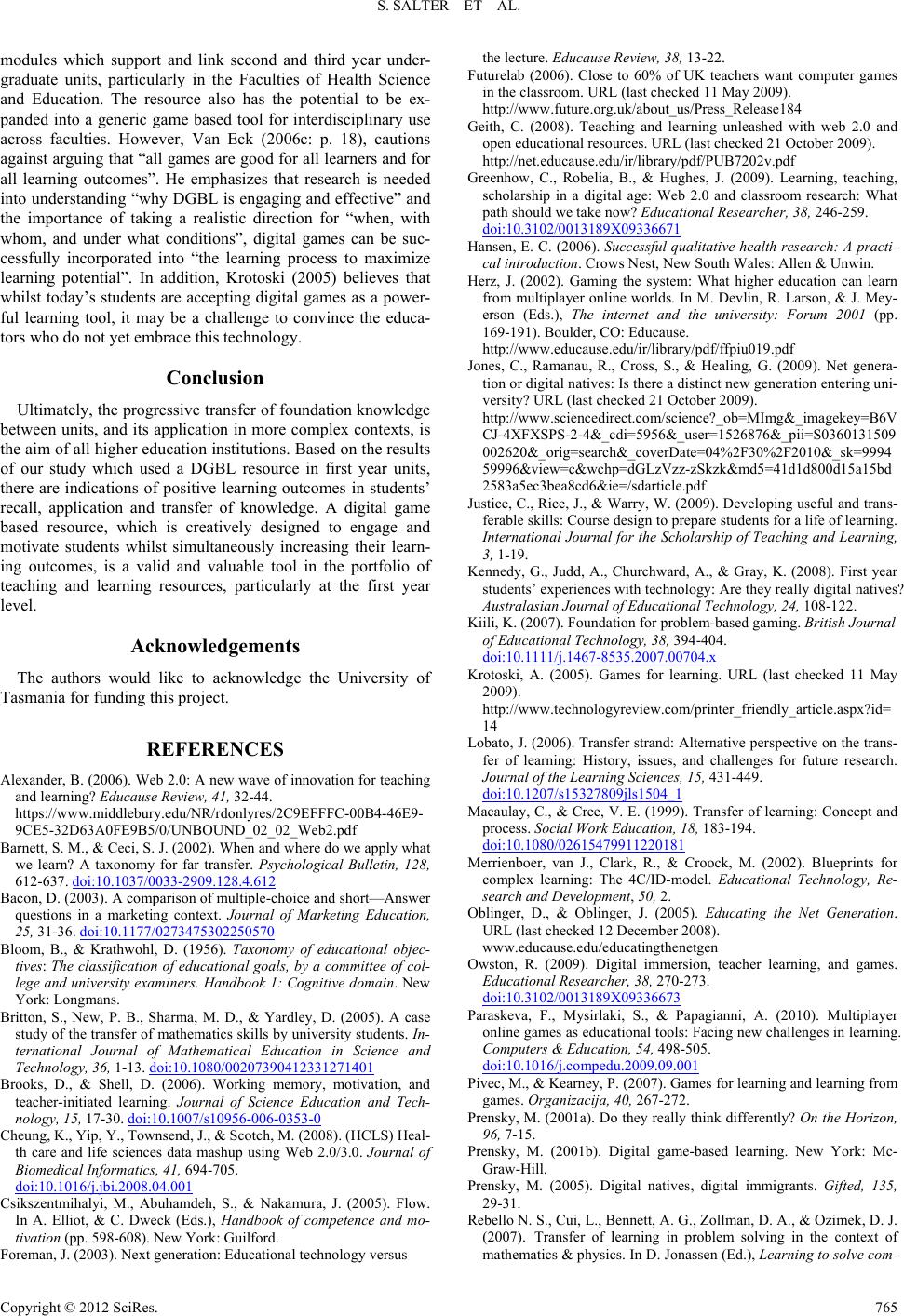
S. SALTER ET AL.
Copyright © 2012 SciRes. 765
modules which support and link second and third year under-
graduate units, particularly in the Faculties of Health Science
and Education. The resource also has the potential to be ex-
panded into a generic game based tool for interdisciplinary use
across faculties. However, Van Eck (2006c: p. 18), cautions
against arguing that “all games are good for all learners and for
all learning outcomes”. He emphasizes that research is needed
into understanding “why DGBL is engaging and effective” and
the importance of taking a realistic direction for “when, with
whom, and under what conditions”, digital games can be suc-
cessfully incorporated into “the learning process to maximize
learning potential”. In addition, Krotoski (2005) believes that
whilst today’s students are accepting digital games as a power-
ful learning tool, it may be a challenge to convince the educa-
tors who do not yet embrace this technology.
Conclusion
Ultimately, the progressive transfer of foundation knowledge
between units, and its application in more complex contexts, is
the aim of all higher education institutions. Based on the results
of our study which used a DGBL resource in first year units,
there are indications of positive learning outcomes in students’
recall, application and transfer of knowledge. A digital game
based resource, which is creatively designed to engage and
motivate students whilst simultaneously increasing their learn-
ing outcomes, is a valid and valuable tool in the portfolio of
teaching and learning resources, particularly at the first year
level.
Acknowledgements
The authors would like to acknowledge the University of
Tasmania for funding this project.
REFERENCES
Alexander, B. (2006). Web 2.0: A new wave of innovation for teaching
and learning? Educause Review, 41, 32-44.
https://www.middlebury.edu/NR/rdonlyres/2C9EFFFC-00B4-46E9-
9CE5-32D63A0FE9B5/0/UNBOUND_02_02_Web2.pdf
Barnett, S. M., & Ceci, S. J. (2002). When and where do we apply what
we learn? A taxonomy for far transfer. Psychological Bulletin, 128,
612-637. doi:10.1037/0033-2909.128.4.612
Bacon, D. (2003). A comparison of multiple-choice and short—Answer
questions in a marketing context. Journal of Marketing Education,
25, 31-36. doi:10.1177/0273475302250570
Bloom, B., & Krathwohl, D. (1956). Taxonomy of educational objec-
tives: The classification of educational goals, by a committee of col-
lege and university examiners. Handbook 1: Cognitive domain. New
York: Longmans.
Britton, S., New, P. B., Sharma, M. D., & Yardley, D. (2005). A case
study of the transfer of mathematics skills by university students. In-
ternational Journal of Mathematical Education in Science and
Technology, 36, 1-13. doi:10.1080/00207390412331271401
Brooks, D., & Shell, D. (2006). Working memory, motivation, and
teacher-initiated learning. Journal of Science Education and Tech-
nology, 15, 17-30. doi:10.1007/s10956-006-0353-0
Cheung, K., Yip , Y., Townsend, J., & Scotch, M. (2008). (HCLS) Heal-
th care and life sciences data mashup using Web 2.0/3.0. Journal of
Biomedical Informatics, 41, 694-705.
doi:10.1016/j.jbi.2008.04.001
Csikszentmihalyi, M., Abuhamdeh, S., & Nakamura, J. (2005). Flow.
In A. Elliot, & C. Dweck (Eds.), Handbook of competence and mo-
tivation (pp. 598-608). New York: G uilford.
Foreman, J. (20 03 ). Next generation: Educational technology ver sus
the lecture. Educause Review, 38, 13-22.
Futurelab (2006). Close to 60% of UK teachers want computer games
in the classroom. URL (last checked 11 May 2009).
http://www.future.org.uk/about_us/Press_Release184
Geith, C. (2008). Teaching and learning unleashed with web 2.0 and
open educational resources. URL (last checked 21 October 2009).
http://net.educause.edu/ir/library/pdf/PUB7202v.pdf
Greenhow, C., Robelia, B., & Hughes, J. (2009). Learning, teaching,
scholarship in a digital age: Web 2.0 and classroom research: What
path should we take now? Educational R e se arche r, 38, 246-259.
doi:10.3102/0013189X09336671
Hansen, E. C. (2006). Successful qualitative health research: A practi-
cal introduction. Crows N e s t , N ew South Wales: Allen & Unwin.
Herz, J. (2002). Gaming the system: What higher education can learn
from multiplayer online worlds. In M. Devlin, R. Larson, & J. Me y-
erson (Eds.), The internet and the university: Forum 2001 (pp.
169-191). Boulder, CO: Educause.
http://www.educause.edu/ir/library/pdf/ffpiu019.pdf
Jones, C., Ramanau, R., Cross, S., & Healing, G. (2009). Net genera-
tion or digital natives: Is there a distinct new generation entering uni-
versity? URL (last checked 21 October 2009).
http://www.sciencedirect.com/science?_ob=MImg&_imagekey=B6V
CJ-4XFXSPS-2-4&_cdi=5956&_user=1526876&_pii=S0360131509
002620&_orig=search&_coverDate=04%2F30%2F2010&_sk=9994
59996&view=c&wchp=dGLzVzz-zSkzk&md5=41d1d800d15a15bd
2583a5ec3bea8cd6&ie=/sdarticle.pdf
Justice, C., Rice, J., & Warry, W. (2009). Developing useful and trans-
ferable skills: Course design to prepare students for a life of learning.
International Journal for the Scholarship of Teaching and Learning,
3, 1-19.
Kennedy, G., Judd, A., Churchward, A., & Gray, K. (2008). First year
students’ experiences with technology: Are they really digital natives?
Australasian Journal of Educational Technology, 24, 108-122.
Kiili, K. (2007). Foundation for problem-based gaming. British Journal
of Educational Technology, 38, 394-404.
doi:10.1111/j.1467-8535.2007.00704.x
Krotoski, A. (2005). Games for learning. URL (last checked 11 May
2009).
http://www.technologyreview.com/printer_friendly_article.aspx?id=
14
Lobato, J. (2006). Transfer strand: Alternative perspective on the trans-
fer of learning: History, issues, and challenges for future research.
Journal of the Learning Sciences, 15, 431-449.
doi:10.1207/s15327809jls1504_1
Macaulay, C., & Cree, V. E. (1999). Transfer of learning: Concept and
process. Social Work Education, 18, 183-194.
doi:10.1080/02615479911220181
Merrienboer, van J., Clark, R., & Croock, M. (2002). Blueprints for
complex learning: The 4C/ID-model. Educational Technology, Re-
search and Development, 50, 2.
Oblinger, D., & Oblinger, J. (2005). Educating the Net Generation.
URL (last checked 12 December 2008).
www.educause.edu/educatingthenetgen
Owston, R. (2009). Digital immersion, teacher learning, and games.
Educational Researcher, 38, 270-273.
doi:10.3102/0013189X09336673
Paraskeva, F., Mysirlaki, S., & Papagianni, A. (2010). Multiplayer
online games as educational tools: Facing new challenges in learning.
Computers & Education, 54, 498-505.
doi:10.1016/j.compedu.2009.09.001
Pivec, M., & Kearney, P. (2007). Games for learning and learning from
games. Organizacija, 40, 267-272.
Prensky, M. (2001a). Do they really think differently? On the Horizon,
96, 7-15.
Prensky, M. (2001b). Digital game-based learning. New York: Mc-
Graw-Hill.
Prensky, M. (2005). Digital natives, digital immigrants. Gifted, 135,
29-31.
Rebello N. S., Cui, L., Bennett, A. G. , Zoll man, D. A. , & Ozimek, D . J.
(2007). Transfer of learning in problem solving in the context of
mathematics & physics. In D. Jonassen (Ed.), Learning to solve com-